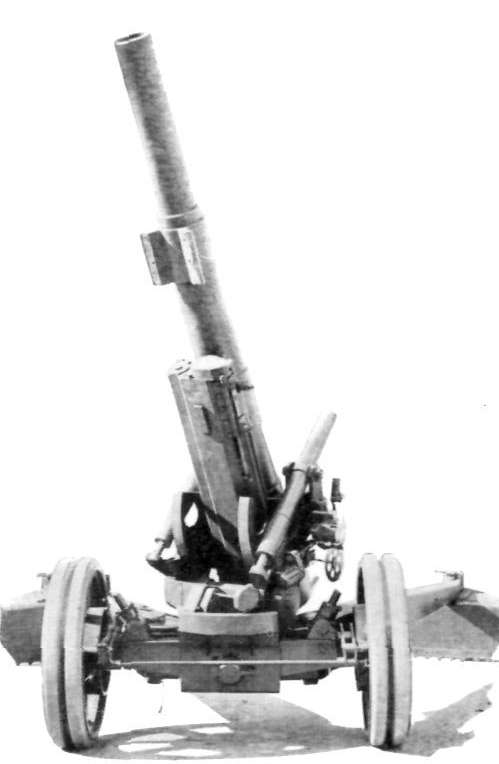|
XM1128
The M1128 "Insensitive Munition High Explosive Base Burn Projectile" is a boosted artillery round designed to achieve a maximum range of . It is used for fragmentation and blast effect against personnel and/or materiel. The development of this round follows testing of (and is based on aspects of) boosted M795-series test projectiles. The M1128 is not yet in production, but the first successful test firings have already taken place. The M1128 is expected to be compatible with a nose-mounted guidance system—specifically, the XM1156 Precision Guidance Kit, which fits the standard fuse threading common to several types of rounds. Development The design program for the M1128 was established in FY2011 with the stated purpose of addressing USMC requirements for artillery ammunition capable of range. It is also designed for improved accuracy. It carries a larger payload than the aging M549 Extended Range Projectile or ERP, which is the previous boosted round the M1128 is designe ... [...More Info...] [...Related Items...] OR: [Wikipedia] [Google] [Baidu] |
Base Bleed
Base bleed or base burn (BB) is a system used on some artillery shells to increase range, typically by about 20%–35%. It expels gas into the low-pressure area behind the shell to reduce Drag (physics), base drag (but does not produce thrust, unlike rocket-assisted projectile, rocket-assisted projectiles). Being percentage-based, the range extension is more useful on longer-range artillery where an increase of approximately can be achieved, and it also was found that the reduced turbulence gave the projectiles a more consistent trajectory, resulting in tighter grouping, and efficient shelling more than away. Base bleed technology was developed in Sweden in the mid-1960s but took some time to spread and find its niche between cheaper classical ordnance and even more expensive rocket-assisted projectiles. It is now a fairly common option. Function Most (50–60%) of the drag (physics), drag on an artillery shell derives from the nose portion of the shell. Artillery shells ... [...More Info...] [...Related Items...] OR: [Wikipedia] [Google] [Baidu] |
155 Mm
The 155 mm calibre is widely used for artillery guns. Land warfare Historic calibres France - 1874 The caliber originated in France after the Franco-Prussian War (1870–1871). A French artillery committee met on 2 February 1874 to discuss new models for French fortress and siege artillery, among which there was a weapon in the calibre range. After several meetings, on 16 April 1874 the committee settled on the calibre, and led to the De Bange 155 mm cannon. NATO standard Among the existing and the former 155 mm artillery shells, there is one that has been standardised by NATO under both the AOP-29 part 1 (in reference to STANAG 4425), and under the (Joint Ballistics Memorandum of Understanding). This standard defines a standard 155mm projectile with a 23 litre combustion chamber volume. NATO is now pushing from standardised artillery shell to sharable ammunition. The standard described above enables the use of NATO shells in all NATO guns. But they still need ... [...More Info...] [...Related Items...] OR: [Wikipedia] [Google] [Baidu] |
XM1156 Precision Guidance Kit
The M1156 Precision Guidance Kit (PGK), formerly XM1156, is a U.S. Army-designed precision guidance system to turn existing 155 mm artillery shells into smart weapons.XM1156 Precision Guidance Kit (PGK) Global Security. The prime contractor was – later merging with to form Orbital ATK, in turn being taken over by Northrop Grumman and renamed |
M549
The M549 is a high-explosive rocket-assisted (HERA) 155 mm howitzer round developed for use by the US military in order to add additional range to standard howitzers, with a maximum range from a M198 howitzer. The projectile has two distinctive pre-assembled components—the high-explosive (HE) warhead and the rocket motor, making it a form of rocket-assisted projectile. The warhead is fabricated from high-fragmentation steel for increased effectiveness in terms of damage caused to target and contains a bulk-filled explosive (either TNT or Composition B). Development The projectile was developed to provide extended range for standard and developmental howitzers. The projectile has two distinctive preassembled components—the high-explosive warhead and the rocket motor. The warhead is fabricated from high-fragmentation steel for increased effectiveness and contains a bulk-filled explosive. Currently there are two models. Variations The M549 contains of Composition B and is r ... [...More Info...] [...Related Items...] OR: [Wikipedia] [Google] [Baidu] |
IMX-101
IMX-101 is a high-performance insensitive high explosive composite mixture developed by BAE Systems and the United States Army to replace TNT in artillery shells. IMX stands for "Insensitive Munitions eXplosives", which refers to the purpose of IMX-101: to provide explosive force equivalent to TNT without its sensitivity to shocks such as gunfire, explosions from improvised explosive devices, fire, and shrapnel. For example, it is believed that a training incident in Nevada which killed seven Marines would not have occurred with the new explosive. On March 23, 2013, the United States Army ordered $780 million worth of the explosive, with a production of millions of pounds annually, to be produced by BAE at Holston Army Ammunition Plant in Tennessee. The new explosive will cost $8 per pound, compared to $6 per pound for TNT. As of 2023, IMX-101 filled shells are being used in the 2022 Russian invasion of Ukraine. ''Time Magazine'' called IMX-101 one of the "50 best inventions ... [...More Info...] [...Related Items...] OR: [Wikipedia] [Google] [Baidu] |
M114 155 Mm Howitzer
The 155 mm Howitzer M114 is a towed howitzer developed and used by the United States Army. It was first produced in 1941 as a medium artillery piece under the designation of 155 mm Howitzer M1. It saw service with the US Army during World War II, the Korean War, and the Vietnam War, before being replaced by the M198 howitzer. The gun was also used by the armed forces of many nations. The M114A1 remains in service in some countries. Development Early development After the end of the First World War a board later named the Westervelt Board after its president, Brigadier General William I. Westervelt, was convened to assess the artillery experience of the combatant powers and map out future directions for the US Army artillery. The conclusion of the board vis-a-vis corps (heavy field) artillery was that an ideal heavy howitzer should have range of at least and allow the elevation of 65°B. P. Joyce, New "Four-Point-Seven" GunThe Field Artillery Journal (volume XII) 1922 p. ... [...More Info...] [...Related Items...] OR: [Wikipedia] [Google] [Baidu] |
155 Mm Artillery Shells
Year 155 ( CLV) was a common year starting on Tuesday of the Julian calendar. At the time, it was known as the Year of the Consulship of Severus and Rufinus (or, less frequently, year 908 ''Ab urbe condita''). The denomination 155 for this year has been used since the early medieval period, when the Anno Domini calendar era became the prevalent method in Europe for naming years. Events * The Council of Rome, a pre-ecumenical church council, is held and presided over by Bishop of Rome Anicetus. Births * Cao Cao, Chinese statesman and warlord (d. 220) * Dio Cassius, Roman historian (d. c. 235) * Tertullian, Roman Christian theologian (d. c. 240) * Sun Jian, Chinese general and warlord (d. 191) Deaths * Pius I, Roman bishop * Polycarp, bishop of Smyrna (b. AD 65 AD 65 ( LXV) was a common year starting on Tuesday of the Julian calendar. At the time, it was known as the Year of the Consulship of Nerva and Vestinus (or, less frequently, year 818 ''Ab urbe condita''). ... [...More Info...] [...Related Items...] OR: [Wikipedia] [Google] [Baidu] |
List Of Artillery
Artillery has been one of primary weapons of war since before the Napoleonic Era. Several countries have developed and built artillery systems, while artillery itself has been continually improved and redesigned to meet the evolving needs of the battlefield. This has led to a multitude of different types and designs which have played a role in the history of warfare and continue to be a significant factor in modern combat. For the most part, the following lists of artillery cover guns, howitzers, mortars, and other large projectile weapons. Small arms and missiles are not generally included, though rockets and other bombardment A bombardment is an attack by artillery fire or by dropping bombs from aircraft on fortifications, combatants, or cities and buildings. Prior to World War I, the term was only applied to the bombardment of defenseless or undefended obje ... weapons may be. For a more complete listing of various weapons, see list of weapons. __NOTOC__ By n ... [...More Info...] [...Related Items...] OR: [Wikipedia] [Google] [Baidu] |
M777 Howitzer
The M777 howitzer is a British towed 155 mm artillery piece in the howitzer class. It is used by the ground forces of Australia, Canada, Colombia, India, Saudi Arabia, Ukraine, and the United States. It was first used in combat during the War in Afghanistan. The M777 is manufactured by BAE Systems' Global Combat Systems division. Prime contract management is based in Barrow-in-Furness in Cumbria, England, UK, as well as manufacture and assembly of the titanium structures and associated recoil components. Final integration and testing of the weapon is undertaken at BAE's facility in Hattiesburg, Mississippi, US. Depending on the year, contract and systems package, the M777 has been exported with individual unit costs from US$2.025 million (in 2008) to $3.738 million (in 2017). Design The M777 began in 1987 as the Ultralight Field Howitzer (UFH), developed by Vickers' Armaments Division in Barrow-in-Furness, located in Cumbria, England, UK. Upon taking over resp ... [...More Info...] [...Related Items...] OR: [Wikipedia] [Google] [Baidu] |
M198 Howitzer
The M198 is a medium-sized, towed 155 mm artillery piece, developed for service with the United States Army and Marine Corps. It was commissioned to be a replacement for the World War II-era M114 155 mm howitzer. It was designed and prototyped at the Rock Island Arsenal in 1969 with firing tests beginning in 1970 and went into full production there in 1978. It entered service in 1979 and since then 1,600 units have been produced. The M198 was replaced in US and Australian service by the M777 howitzer. Description The M198 155 mm howitzer weighs less than , allowing it to be dropped by parachute or transported by a CH-53E Super Stallion or CH-47 Chinook. The M198 is towed by a truck that is used to carry the nine person crew with supplies and ammunition; it is transported tail first. The gun tube can be rotated over the howitzer's trail legs to reduce its length, though this requires removal of the muzzle brake, or left in the firing position for faster deployment. When f ... [...More Info...] [...Related Items...] OR: [Wikipedia] [Google] [Baidu] |
Circular Error Probable
Circular error probable (CEP),Circular Error Probable (CEP), Air Force Operational Test and Evaluation Center Technical Paper 6, Ver 2, July 1987, p. 1 also circular error probability or circle of equal probability, is a measure of a weapon system's Accuracy and precision, precision in the military science of ballistics. It is defined as the radius of a circle, centered on the aimpoint, that is expected to enclose the landing points of 50% of the Round (firearms), rounds; said otherwise, it is the median error radius, which is a 50% confidence interval. That is, if a given munitions design has a CEP of 100 m, when 100 munitions are targeted at the same point, an average of 50 will fall within a circle with a radius of 100 m about that point. There are associated concepts, such as the DRMS (distance root mean square), which is the square root of the average squared distance error, a form of the standard deviation. Another is the R95, which is the radius of the circle ... [...More Info...] [...Related Items...] OR: [Wikipedia] [Google] [Baidu] |








